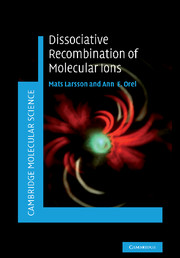Introduction
Published online by Cambridge University Press: 03 May 2010
Summary
This book is focused on a single molecular process, dissociative recombination, and it may at first seem surprising that this topic can fill a whole book. As we shall see, it is not surprising when the complexity and applicability of the process are taken into account, and when the formidable challenges the process has provided to both experimenters and theorists are considered. This book brings together all the information we have on dissociative recombination in a single source, something which so far has been missing from the scientific literature.
A free electron which has a positive kinetic energy recombines with a positive atomic or molecular ion if its energy can be removed, so that it can enter a bound state. In the absence of a third body that can absorb the excess energy, the energy can be carried away by a photon. This is the only option for an atomic ion, and the process is inefficient. A molecular ion can make use of its internal structure and transfer the electron to a bound state while breaking one or several chemical bonds. This is a very efficient process that has taken its name from the fact that the capture of the electron is stabilized by dissociation. It is a primary chemical process, but is rarely described in chemical textbooks. It is the most complex of gas-phase reactions leading to the production of neutral atoms and molecules.
- Type
- Chapter
- Information
- Dissociative Recombination of Molecular Ions , pp. 1 - 10Publisher: Cambridge University PressPrint publication year: 2008

